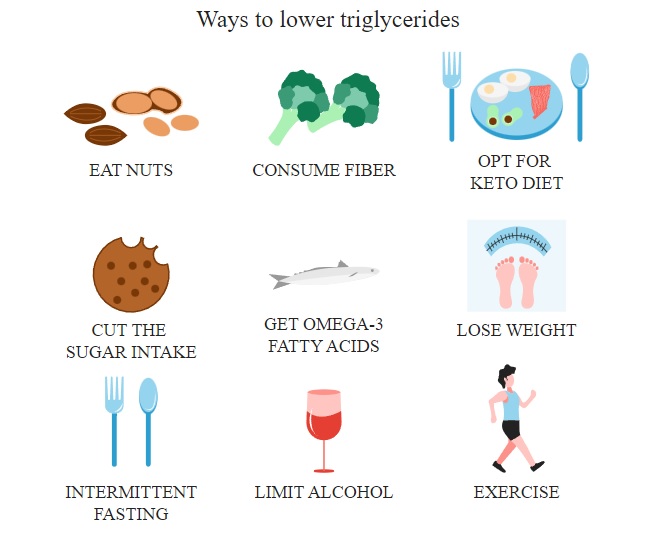Triglycerides are crucial fats in our body composed of glycerol and three fatty acids. When we eat more calories than our body requires for immediate energy needs, the surplus energy is transformed into triglycerides. These triglycerides travel through the bloodstream and get stored as fat droplets in adipose tissue serving as a convenient energy reserve that can be utilized during periods between meals and physical activities. The reason why foods such as avocados, nuts and dairy products are so wonderful in taste and texture is that they contain triglycerides. In a blood sample, triglycerides can appear milky or cloudy due to their lipid nature. This phenomenon is more noticeable when triglycerides are significantly elevated.
Some triglycerides are liquid at room temperature such as those in vegetable oils. The melting point of triglycerides depends on the length and saturation of the fatty acid chains. Also, triglycerides can dissolve in organic solvents like ethanol and acetone but not in water.

The levels of triglycerides can change with age and gender. Generally speaking, men tend to have a slightly greater triglyceride level than women and these levels tend to increase as people age. Also, an interesting thing is that triglyceride levels can vary between racial and ethnic groups. For instance, research indicates that individuals with South Asian heritage might exhibit elevated triglyceride levels in comparison to other populations.
The importance of triglyceride control in the general population is highlighted by data from the National Health and Nutrition Examination Survey (NHANES), which shows around 33% of adults in the United States, have increased triglyceride levels. NHANES data indicates that approximately 23% of adults in the United States have metabolic syndrome. Heart and blood vessel diseases are a major cause of death globally. High triglyceride levels contribute significantly to this burden. The Global Burden of Study estimates that nearly 17.9 million people died from cardiovascular diseases in 2019 representing 32.1% of all global deaths.
Physical Activity and Lipid Metabolism: Historical Evidence
Early observations by Thomas Lewis, a British Physician highlighted the positive impact of exercise on cardiac output and circulation. Jeremiah Morris conducted a study involving civil servants which revealed that physically active people had lower rates of coronary heart disease. This suggests a possible connection between physical activity and heart health.
Additionally, the Lipid Research Clinics Coronary Primary Prevention Trial provided compelling evidence that exercise, in combination with dietary changes, can positively impact lipid metabolism. These historical findings have paved the way for more research confirming the significance of regular exercise in controlling lipid levels and enhancing cardiovascular health.
Types of Triglycerides
Triglycerides are classified based on the types of fatty acids they contain. There are mainly three types:
Saturated Triglycerides: These contain saturated fatty acids. Example: Butter and lard.
Unsaturated Triglycerides:
- Monosaturated Triglycerides: These have one monosaturated fatty acid. Example: Olive oil.
- Polyunsaturated Triglycerides: These contain one or more polyunsaturated fatty acids. Example: Fish oil
- Trans Triglycerides: These are unsaturated triglycerides containing harmful trans fatty acids. Example: Partially hydrogenated oils found in some processed foods.
It’s essential to consume more healthy unsaturated fats and avoid harmful trans fats to maintain good triglyceride levels and overall health.

Triglycerides: Importance of Health and Wellness
Recognizing the significance of triglycerides and how they affect our health is crucial for sustaining overall well-being.
- Role in cell structures: Triglycerides play a structural role in cell membranes. They help maintain the integrity and fluidity of cell membranes, ensuring proper communication between cells and facilitating various cellular processes.
- Nutrient Absorption: Triglycerides are essential for the absorption of fat-soluble vitamins (A, D, E and K) in the digestive system. These vitamins are crucial for numerous bodily functions including bone health, vision and immune system support.
- Cholesterol Transport: There are two different types of cholesterol, LDL, known as the bad cholesterol and HDL, the good cholesterol. While HDL takes cholesterol away from the arteries to the liver, LDL transports it to body tissues. To keep HDL and LDL cholesterol in a healthy balance, proper triglyceride levels are necessary.
Triglycerides and Health: Elevated Levels and Associated Risks
Although Triglycerides are considered to be very important for our body, high levels of it can cause various forms of diseases such as;
- Cardiovascular diseases: Abnormal levels of triglycerides can cause heart problems including atherosclerosis, coronary artery disease, heart attack and stroke.
- Metabolic syndrome: Triglycerides is considered to be a major factor of metabolic syndrome, a group of disorders that raise the risk of heart disease, and type 2 diabetes.
- Type 2 diabetes: People with diabetes often have higher triglyceride levels increasing their risk of cardiovascular complications.
Diagnosis of Triglyceride levels
Triglyceride levels can be measured through a simple blood test known as a lipid profile or lipid panel. It is typically part of a routine blood test that also includes measurements of total cholesterol, HDL cholesterol and LDL cholesterol.
The following triglyceride-level classifications are commonly used:
Normal: Less than 150 mg/dL
Borderline High: 150-199 mg/dL
High: 200-499 mg/dL
Very High: 500 mg/dL or higher

Medication Options:
Medications can be prescribed to manage elevated triglyceride levels when lifestyle changes alone are insufficient. Some common medications for triglycerides include:
- Statins: Statins are mainly used to lower LDL cholesterol levels, but they can also slightly reduce triglycerides. Some examples of statins include atorvastatin, simvastatin and rosuvastatin.
- Fibrates: Fibrates are specifically designed to lower triglyceride levels and increase HDL cholesterol. Fenofibrate and gemfibrozil are common fibrates used for this purpose.
- Omega-3 Fatty Acid Supplements: Prescription omega-3 fatty acid supplements, such as Vascepa (icosapent ethyl) and Lovaza (omega-3 acid ethyl esters), are used to lower triglyceride levels in people with very high triglycerides.
- Niacin: Niacin, also known as vitamin B3, can lower triglycerides and increase HDL cholesterol levels. However, its use may be limited due to potential side effects.
- PCSK9 Inhibitors: These newer medications, such as evolocumab and alirocumab, are primarily used to lower LDL cholesterol but may also have a beneficial effect on triglycerides.
- Bile Acid Sequestrants: These drugs like colesevelam, primarily lower LDL cholesterol levels but may have some impact on triglycerides.
The Science Behind Triglycerides
Apart from energy storage, triglycerides play other vital roles. They help insulate the body, maintain body temperature, and act as a cushion to protect organs like the kidneys, heart, and liver. Additionally, triglycerides are involved in synthesizing certain hormones and signaling molecules.
Triglycerides are formed through a process that combines fatty acids and glycerol derived from dietary fats and carbohydrates. In adipose tissue, these components recombine to form triglycerides. The stored triglycerides are released through lipolysis when the body requires energy.
The regulation of triglyceride storage and release is tightly controlled by hormones like insulin. This ensures a constant energy supply to meet the body’s needs and helps maintain overall energy balance. Triglycerides play a vital role in supporting various physiological functions, making them an essential component of human metabolism.
Impact of Exercise
Physical activity can influence triglycerides through various mechanisms, and different types of exercise can have distinct effects on lipid metabolism. When we engage in physical activity, our muscles require energy to perform the work. While exercising, triglycerides are broken down into glycerol and fatty acids through a process known as lipolysis. These fatty acids are then transported to the muscles, where they undergo the process of generating energy for muscle contractions. Regular exercise helps improve insulin sensitivity, which can further enhance triglyceride metabolism. Insulin resistance is associated with elevated triglyceride levels, and exercise helps lower insulin resistance, leading to improved triglyceride management. High-intensity exercise reduces abdominal fat by redirecting carbon and nitrogen to muscle for energy and cell regeneration leading to fat loss and muscle gain.
Types of Exercise and Their Influence on Triglycerides:
- Cardiovascular (Aerobic) Exercise: Cardiovascular exercises, such as walking, running, cycling, swimming, and aerobic classes, are highly effective in reducing triglyceride levels. During aerobic activities, the body relies on stored triglycerides as a primary energy source, leading to their breakdown and utilization.
- Resistance (Strength) Training: Resistance training which involves weightlifting and bodyweight exercises can affect triglyceride metabolism. While it doesn’t directly change triglyceride levels during the workout, it helps build muscle mass. More muscle mass leads to a higher resting metabolic rate causing greater energy expenditure even at rest.
- High-Intensity Interval Training (HIIT): HIIT involves alternating between short bursts of intense exercise and brief periods of rest or lower-intensity exercise. HIIT is particularly effective in reducing triglyceride levels. The intense bursts of activity during HIIT increase energy demands, leading to enhanced triglyceride breakdown during and after the workout.
- Combined Exercise Programs: A combination of cardiovascular exercise, resistance training, and HIIT can provide comprehensive benefits for triglyceride metabolism. Combining different exercise modalities can have a synergistic effect, maximizing the utilization of triglycerides and promoting overall lipid profile improvements.
Dietary Considerations for Triglyceride Reduction
Nutrition plays a crucial role in managing triglycerides and overall cardiovascular health. Making appropriate dietary adjustments can complement exercise efforts and help reduce triglyceride levels. Here are some detailed dietary considerations for triglyceride reduction:
- Reduce Saturated and Trans Fats: Limit intake of saturated and trans fats, as they can increase triglyceride levels. Foods high in saturated fats include red meat, full-fat dairy products, butter, and coconut oil. Tran’s fats are commonly present in processed and fried foods commercially baked products and certain margarines. Choose good fats like monounsaturated and polyunsaturated fats found in olive oil, avocados, nuts and seeds.
- Increase Omega-3 Fatty Acids: Omega-3 fatty acids help lower triglyceride levels in the body. Add omega-3 fat sources like fatty fish (salmon, mackerel, sardines), flax seeds, chia seeds, walnuts and soybeans to your diet. Consider incorporating fish into your meals at least twice a week.
- Choose Whole Grains and High-Fiber Foods: Replace refined carbohydrates with whole grains, which have a lower impact on blood sugar and triglycerides. Choose whole wheat, quinoa, brown rice, and oats over refined grains like white bread and pasta. Include more high-fiber foods like fruits, vegetables, legumes and nuts as they improve lipid profiles.
- Limit Added Sugars and Simple Carbohydrates: High consumption of added sugars and simple carbohydrates can elevate triglyceride levels. Reduce intake of sugary beverages, sweets, and processed snacks. Opt for naturally sweetened foods like fruits and use complex carbohydrates for sustained energy.
- Moderate Alcohol Consumption: Consuming alcoholic beverages, especially in excess, can raise triglyceride levels. Alcohol metabolism in the liver can lead to increased triglyceride production. Men should generally consume up to two drinks, while women should limit their intake to up to one drink per day.
- Be Mindful of Portion Sizes and Total Calories: Overeating, even healthy foods, can lead to an excess intake of calories, which may be converted into triglycerides and stored as fat. Pay attention to portion sizes and practice mindful eating to avoid unnecessary calorie intake.
- Consider Mediterranean or DASH Diet: Both the Mediterranean and Dietary Approaches to Stop Hypertension (DASH) diets have been associated with improved lipid profiles. These diets emphasize whole foods, lean proteins, healthy fats, fruits, vegetables, and whole grains while minimizing processed foods and added sugars.
- Stay Hydrated: Proper hydration is essential for overall health and can also help support triglyceride management. Drink plenty of water throughout the day to stay hydrated.
- Consult with a Registered Dietitian: For personalized dietary recommendations and guidance, consider consulting with a registered dietitian. They can assess your individual health needs, lifestyle, and preferences to create a tailored plan to manage triglyceride levels effectively.

Supplements to Lower Triglyceride Level
While some supplements may show promise in supporting triglyceride management, they should not replace a balanced diet and a healthy lifestyle. Before you take any supplements, always consult with a healthcare professional. Here are some supplements that have been studied for their potential effects on triglyceride levels:
- Omega-3 Fatty Acids: Omega-3 fatty acids, found in fish oil supplements, have been studied extensively for their heart-healthy benefits, including potential triglyceride-lowering effects. The two primary omega-3 fatty acids in fish oil are eicosapentaenoic acid (EPA) and docosahexaenoic acid (DHA). These supplements may be beneficial for individuals with elevated triglycerides.
- Niacin (Vitamin B3): Niacin has been used to help lower triglycerides and raises high-density lipoprotein (HDL) cholesterol levels. However, niacin supplements should only be taken under the guidance of a healthcare professional due to potential side effects.
- Fiber Supplements: Some soluble fiber supplements, such as psyllium husk, have shown potential in supporting healthy triglyceride levels. Soluble fiber can help improve cholesterol and triglyceride levels when incorporated into a balanced diet.
- Garlic: Garlic supplements have been studied for their potential cardiovascular benefits, including potential effects on triglycerides. However, the evidence is not as strong as it is for other interventions.
- Plant Sterols and Stanols: Plant sterols and stanols are substances found in certain plants and are added to some cholesterol-lowering margarine and supplements. They could help lower LDL cholesterol levels, which may have an indirect impact on triglycerides.
- Green Tea Extract: Green tea contains antioxidants known as catechins, which may have a modest effect on triglycerides and cholesterol levels.
Some Common Questions on Triglycerides
How much exercise is recommended to improve triglyceride levels?
Engaging in at least 150 minutes of moderate-intensity aerobic exercise or 75 minutes of vigorous-intensity aerobic exercise per week is recommended to improve triglyceride levels.
Can triglyceride levels be too low?
Extremely low triglyceride levels can be concerning and may indicate malnutrition, liver disease, or other health issues. It’s essential to maintain a balance and consult a healthcare professional if triglyceride levels seem unusually low.
Is it possible that certain medications could increase triglyceride levels?
Yes, certain medications like beta-blockers, corticosteroids and specific diuretics can raise triglyceride levels in the body. If you’re on medication and concerned about your triglycerides, discuss it with your healthcare provider.
Can stress affect triglyceride levels?
Yes, chronic stress may influence triglyceride levels through hormonal changes and unhealthy coping mechanisms like emotional eating. Managing stress through relaxation techniques and regular exercise can be beneficial for triglyceride management.









